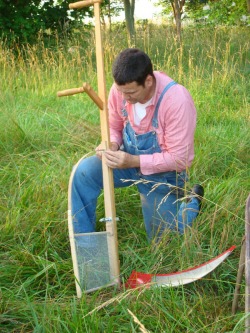 Hello Botan, Your site is a great resource for folks (like me) wanting to learn about sustainable farming. I think of the thing that I made as a "catcher" or "pusher" modification to a mowing scythe for the purpose of harvesting grain. From watching the video on your site, I could not tell if those German farmers had a temporary addition to their scythe or not (though I thought so because at the end, the guy detached his blade and re-attached it under the clamp along the snath), but I wanted mine to be detachable. And that's the real difference in my mind-- one is a temporary modification to a tool to get a specific job done and the other is a permanent and specialized tool. For example, one would not want to use a grain cradle to mow a lawn! (The cradles I've seen have really short snaths and long, wooden tines going out over, parallel to the blade.) David Tresemer, in his The Scythe Book, shows an "F.A.O cradle" (figure 26) that is very similar to the catcher, but it is bent inward (at the blade end) out over the beard of the blade. It does appear to be a temporary attachment. As June was half gone and my wheat would be ready to cut in a week or so, I decided to make the catcher using a half inch thick, 30-some inch long piece of oak that I cut to a tapering width. I used dowels of 7/16" diameter and cut them about a foot long. I guestimated that the Germans (I saw on your video) had a catching width of about ten inches (where hardware cloth or 1/4" wire mesh would be spanned-- but it could be screen-door screen) and a bow support span of about 14 inches. I drilled the oak and "footed" the dowels adding an extra thickness of oak at the snath end of the dowels thinking that here is greatest stress during a heavy stroke. This was glued with "liquid nails." I then attempted to use a single piece of finely tapered oak to "cap" the dowels at the top and flex the thin end downward for a support bow. I broke the piece (even though i had soaked it). I decided to cap the dowels with drilled pine (again glued with "liquid nails") and just rough, wire-splice the remaining oak bow to it... There was wheat to cut and this was not an art project! I footed the support bow to a dowel cut short (and half along its length) set in the oak. This provides a "stop" for the bow and a place to twist wire against. I believe that mechanical bonds are best for this type of piece (they're faster too). Once the piece was built, I had to add the mesh. I used the same 1/4" mesh from my soil-sifter (for making building cob). I bent the mesh all the way around both dowels and then wired the mesh in place. Then i just needed clamps to attach it to my snath. I use what I call "European, clothesline clamps." I could only find one (to start) so I tied the up and the down end of the catcher with twine and went to cut wheat. I did find that cutting "away from the wall" (with this "catcher" attached) in a stand of ripe wheat makes lovely windrows that, with some practice, are very neat and ready for bundling or sheaving. I also learned that the attachment should not go beyond the end of the snath more than an inch or so. With my height and the way I cut, the catcher tended to not keep all of the cuttings from a stroke unless it was slightly extended beyond the end of the snath. And this is, I am fairly sure, how the originators of the true grain cradle developed their design, because, as I cut, I watched and wanted to keep all the cuttings from a single stroke. Often, many of these would be captured to the windrow in the next stroke, but some would be laid down by the back swing away from the windrow. (Here is the work of the gatherer/raker also!!) Perhaps the slight bend of the FAO cradle is the "next step" I am looking for. My inclination is to make tines that reach out over the blade OR span a line from the outward part (highest, furthest from blade) of the catcher to the beak or tip of the blade. When using the device harvesting rye, I found that it is good to sometimes cut "into the wall" to support the very long straw (which is good for making hats, etc. My rye was twice as tall as my wheat.) Early in the day, the rye seemed to want to fall over the top of the catcher and make a mess unless cutting in. It was just too tall and heavy. By late morning though, the dew was gone and I could lay down neat windrows. I only had one acre of wheat and about 1/3 acre of rye. I really believe that the catcher saves a lot of raking and gathering. I did not try harvesting without it (nor would I want to). It did its job as intended. For what it's worth, the snath pictured is a standard Marugg hickory snath (for my height) and the blade is a Jokele bought from (and first peened by) Bernhard Lehnert. It occurred to me to tell you, one of the best pictures on your site is you along with like ten "scythe friends." There is power in community!! The reason I think this, is because I really learned, even an acre is very large when working all by yourself (or with one other person). The field of grain, even a half acre, should be harvested, (in my opinion) by a scytheman, 2 binders, 2 gatherers/rakers and a picnicker (a "caterer" who has drinks and a meal ready for all harvesters). If everyone has cutting experience, everyone can rotate. If none other than the mower have experience, the binders can switch off with the rakers, etc. You may want to see Noah Kellerman's pedaled grain thresher for small scale grain growers.. I think I will try to better his design. Check it out. I hope this information helps you and others. Thank you. - Leigh Waltz
2 Comments
Your comment will be posted after it is approved.
Leave a Reply. |
Botan AndersonArchives
March 2023
Categories
All
|
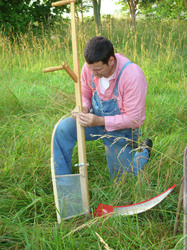
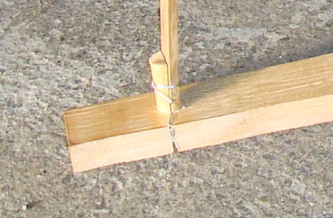
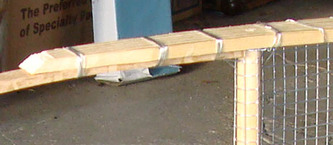
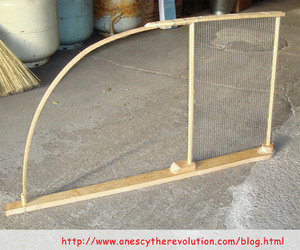

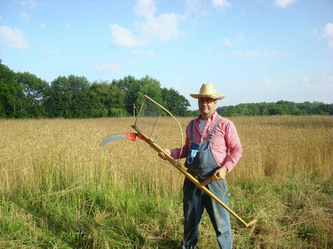
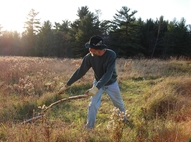
 RSS Feed
RSS Feed